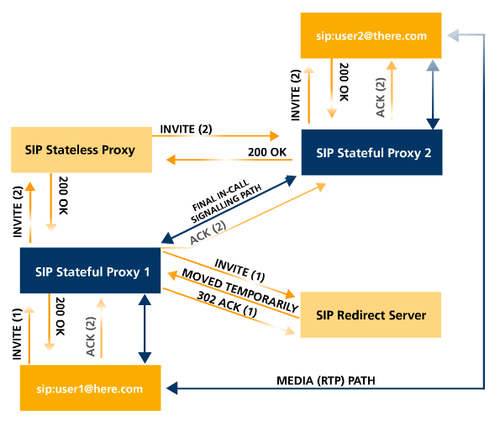Session Initiation Protocol :SIP Application layer protocal
The Session Initiation Protocol (SIP) is a signaling communications protocol, widely used for controlling multimedia communication sessions such as voice and video calls over Internet Protocol (IP) networks.
The protocol defines the messages that are sent between endpoints which govern establishment, termination and other essential elements of a call. SIP can be used for creating, modifying and terminating sessions consisting of one or several media streams. SIP can be used for two-party (unicast) or multiparty (multicast) sessions. Other SIP applications include video conferencing, streaming multimedia distribution, instant messaging, presence information, file transfer, fax over IP and online games.
Originally designed by Henning Schulzrinne and Mark Handley in 1996, SIP has been developed and standardized in RFC 3261 under the auspices of the Internet Engineering Task Force (IETF). It is an application layer protocol designed to be independent of the underlying transport layer; it can run on Transmission Control Protocol (TCP), User Datagram Protocol (UDP) or Stream Control Transmission Protocol (SCTP).[1] It is a text-based protocol, incorporating many elements of the Hypertext Transfer Protocol (HTTP) and the Simple Mail Transfer Protocol (SMTP).[2]
SIP works in conjunction with several other application layer protocols that identify and carry the session media. Media identification and negotiation is achieved with the Session Description Protocol (SDP). For the transmission of media streams (voice, video) SIP typically employs the Real-time Transport Protocol (RTP) or Secure Real-time Transport Protocol (SRTP). For secure transmissions of SIP messages, the protocol may be encrypted with Transport Layer Security (TLS).
List of SIP request methods
- REGISTER: Used by a UA to indicate its current IP address and the URLs for which it would like to receive calls.
- INVITE: Used to establish a media session between user agents.
- ACK: Confirms reliable message exchanges.
- CANCEL: Terminates a pending request.
- BYE: Terminates a session between two users in a conference.
- OPTIONS: Requests information about the capabilities of a caller, without setting up a call.
A new method has been introduced in SIP in RFC 3262:[14]
- PRACK (Provisional Response Acknowledgement): PRACK improves network reliability by adding an acknowledgement system to the provisional Responses (1xx). PRACK is sent in response to provisional response (1xx).
The SIP response types defined in RFC 3261 fall in one of the following categories:[15]
- Provisional (1xx): Request received and being processed.
- Success (2xx): The action was successfully received, understood, and accepted.
- Redirection (3xx): Further action needs to be taken (typically by sender) to complete the request.
- Client Error (4xx): The request contains bad syntax or cannot be fulfilled at the server.
- Server Error (5xx): The server failed to fulfill an apparently valid request.
- Global Failure (6xx): The request cannot be fulfilled at any server.
